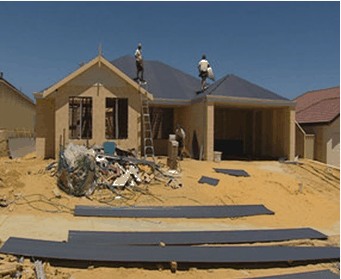
This blog has argued feverishly that exorbitant land costs are the key driver of higher housing prices in Australia.
For example, using data derived from the Australian Bureau of Statistics (ABS) and the Reserve Bank of Australia (RBA), one can show that the value of residential land relative to Australia’s GDP has roughly doubled since the mid-1990s, whereas the value of residential structures has remained roughly constant (see below chart).
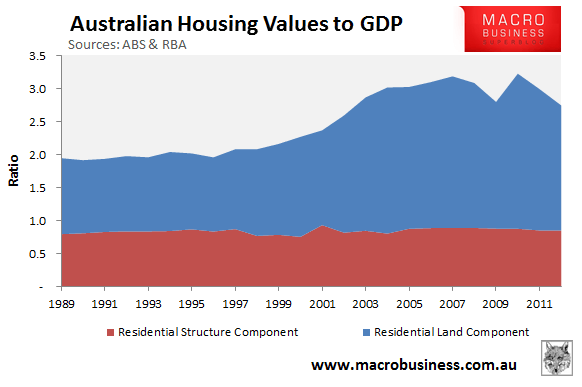
Presented another way, land today accounts for roughly 70% of the total value of housing, versus only 59% in 1995 (see next chart).
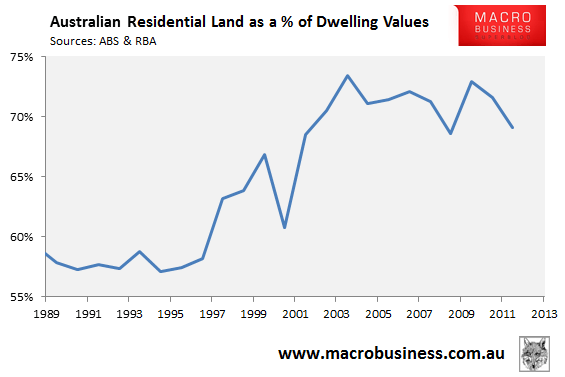
This escalation of land costs has also occurred at the fringe of Australia’s cities, where land prices have surged despite average block sizes shrinking in size (see below).
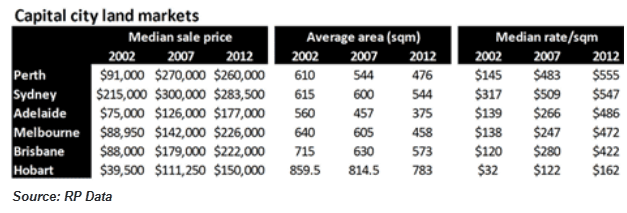
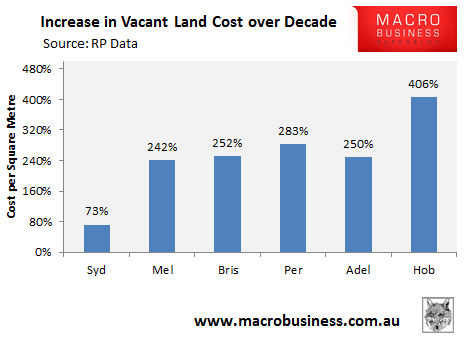
As argued previously, the escalating land prices and shrinking block sizes have been caused, in part, by urban consolidation policies pursued by the state governments since the late-1990s, including: the implementation of urban growth boundaries (UGBs) around Australia’s cities; minimum density ratios; up-front infrastructure/development charges; slower approval times, and more restrictive zoning.
These policies have helped to push-up the cost of fringe land, both necessitating the move to smaller block sizes (in order to maintain some semblance of affordability) as well as forcing-up the cost of new and pre-existing homes.
Government planners and green groups would argue that the shrinkage of block size is desirable as it enables a more efficient use of ‘scarce’ land resources and will some how make households less reliant on their cars via more intensive use of public transport (even though most people don’t work in the inner core). What these groups often fail to concede is the pernicious effects that urban consolidation policies have on housing affordability as well as the perverse outcomes caused by the urban growth constraints themselves.
For example, the building of large houses on tiny blocks, with narrow footpaths and roads (because of the excessive land prices), allows little room to plant trees or veggie gardens. It also means that homes are so close together that many do not contain roof eves or verandas and have poor air flow, thereby requiring greater air conditioning in the summer. The lack of backyards and open space also encourages children to remain inside playing video games and watching TV, which of course uses more energy.
Moreover, the imposition of UGBs often leads to lower income households ‘leapfroging’ the UGB and settling in far flung exurban towns where housing is more affordable. UGBs, therefore, can act to exacerbate urban ‘sprawl’ and increase car reliance and energy usage, which has detrimental distributional impacts in particular on lower socio-economic groups.
Yesterday, it was also revealed that Australian home builders are now cutting corners and sacrificing build quality in order to save on costs and maintain profitability:
HOMEBUILDERS are opting for cheaper houses, given weaker economic conditions and problems with affordability, building supplies giant James Hardie says.
Chief executive Louis Gries says homebuilders generally are building cheaper houses to ensure they can still make a profit.
Builders were “value-engineering” and “de-featuring” houses to lower costs.
Houses are also smaller and being built with lower-cost materials.
Granite bench tops that once may have been standard are now optional.
“They pull any costs out of the home that homeowners are not aware of,” Mr Gries said on Wednesday, after announcing a return to profitability in James Hardie’s third quarter.
“Meaning it’s not easy to see if you’ve got five-eighth-inch gypsum (plasterboard) or half-inch gypsum, or if you have 24-inch spacing on studs versus 16 (inches), or you have two-by-sixes or two-by-fours (the width and depth in inches of wooden planks used in construction).”
When vacant land prices are at $200,000, and affordability cuts out at $350,000, there is not a lot of margin for home builders to make a profit. As such, they have little option but to cut corners and build a cheaper sub-standard product.
Low quality homes bunched close together (without roof eves) on narrow streets without trees (to optimise on space) is a symptom of poor planning and exorbitant land prices.

